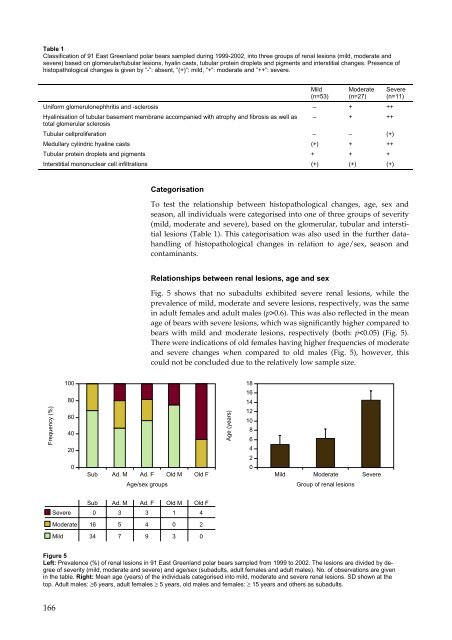Organohalogen concentrations and a gross and histologic ...
Organohalogen concentrations and a gross and histologic ...
Organohalogen concentrations and a gross and histologic ...
Create successful ePaper yourself
Turn your PDF publications into a flip-book with our unique Google optimized e-Paper software.
Table 1<br />
Classification of 91 East Greenl<strong>and</strong> polar bears sampled during 1999-2002, into three groups of renal lesions (mild, moderate <strong>and</strong><br />
severe) based on glomerular/tubular lesions, hyalin casts, tubular protein droplets <strong>and</strong> pigments <strong>and</strong> interstitial changes. Presence of<br />
histopathological changes is given by ”-”: absent, ”(+)”: mild, ”+”: moderate <strong>and</strong> ”++”: severe.<br />
166<br />
Categorisation<br />
Mild<br />
(n=53)<br />
To test the relationship between histopathological changes, age, sex <strong>and</strong><br />
season, all individuals were categorised into one of three groups of severity<br />
(mild, moderate <strong>and</strong> severe), based on the glomerular, tubular <strong>and</strong> interstitial<br />
lesions (Table 1). This categorisation was also used in the further datah<strong>and</strong>ling<br />
of histopathological changes in relation to age/sex, season <strong>and</strong><br />
contaminants.<br />
Relationships between renal lesions, age <strong>and</strong> sex<br />
Moderate<br />
(n=27)<br />
Uniform glomerulonephhritis <strong>and</strong> -sclerosis – + ++<br />
Hyalinisation of tubular basement membrane accompanied with atrophy <strong>and</strong> fibrosis as well as<br />
total glomerular sclerosis<br />
– + ++<br />
Tubular cellproliferation – – (+)<br />
Medullary cylindric hyaline casts (+) + ++<br />
Tubular protein droplets <strong>and</strong> pigments + + +<br />
Interstitial mononuclear cell infiltrations (+) (+) (+)<br />
Frequency (%)<br />
100<br />
80<br />
60<br />
40<br />
20<br />
Severe<br />
0<br />
Moderate<br />
Mild<br />
Severe<br />
(n=11)<br />
Fig. 5 shows that no subadults exhibited severe renal lesions, while the<br />
prevalence of mild, moderate <strong>and</strong> severe lesions, respectively, was the same<br />
in adult females <strong>and</strong> adult males (p>0.6). This was also reflected in the mean<br />
age of bears with severe lesions, which was significantly higher compared to<br />
bears with mild <strong>and</strong> moderate lesions, respectively (both: p

















